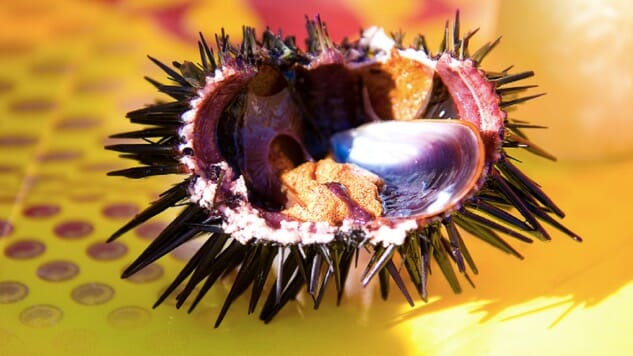A few days earlier, my wife and I met a Korean artist named Steve at an art gallery in Spanish Harlem. After initially chatting about art, the topic shifted to NYC restaurants.
“Have you had fresh octopus?” asked Steve.
“But was it fresh, with the legs still moving?” Steve countered.
“No, it isn’t alive,” he explained. “There is a restaurant in Koreatown that serves the octopus right after killing it. The legs are still moving when they put the plate on the table. We should go.”
I later learned that most restaurants remove the tentacles while the octopus is still alive, making it a dish I would not order if fully informed. However, I didn’t know this at the time, and it was a traditional dish rarely served outside Korea, so I couldn’t say no.
As we entered Sik Gaek Chun Ha, it was clear this place was a party spot, a la Andres Carne de Reis in Colombia or Kryivka in Ukraine. The 2016 Michelin Guide described it best: “Dressed in silly costumes, the staff is always having a blast in this seasonally decorated shack-like dining room featuring corrugated metal roofs, street lights, buckets for shells, and walls papered in dollar bills. Booths along the edge are filled with noisy regulars.”
“The music is super loud,” I said as we entered the restaurant. The soundtrack ranged from English-language dance hits to upbeat K-pop songs that sounded like “Gangnam Style” rip-offs.
The hostess sat us in a large booth against the wall, and the table had a barbeque grill built into the center. In addition to the fresh octopus ($99 as of December 2016), the menu included dishes like spicy BBQ chicken, marinated pork belly, monkfish soup and edgier options like spicy chicken feet and god fish soup. (I assume they meant goldfish, but I didn’t want to know either way.) Steve’s girlfriend and my wife proceeded to check out the restaurant’s more traditional items.
“You’re crazy if you think I’m going to eat live octopus,” my wife proclaimed.
Some people order a seafood hotpot or similar chul pan option that includes the wiggling legs in an overall mix, but Steve ordered the octopus-only plate that the English-language menu described as letting “an octopus dance on the hot plate.”
When the server arrived, I tried to order a drink. “I’ll have the watermelon soju.” My request was met with a blank stare. The server then turned to Steve, who proceeded to place everyone’s order in Korean. “Many of the people here only speak Korean,” he said after the server headed to the kitchen.
Our drinks came out first, and my watermelon soju—an iced alcoholic drink served inside half a hollowed-out watermelon shell—must have taken up a quarter of the table. Unfortunately, the drink seemed light on booze, which was not good for the culinary challenge that awaited.
“Shit,” I said, looking at the fresh octopus plate as it arrived.
I decided not to look up the dish online, so this was the first time I actually saw what it entailed. The server put a plate full of moving tentacles in the middle of the table, and Steve and I immediately grabbed chopsticks to keep the legs from crawling off the plate. The moving arms were served raw with nothing more than sesame oil and soy sauce.
Jon Yao, owner and chef of the tasting menu-only Kato in West Los Angeles, later explained to me the need for the oil, and it wasn’t exactly reassuring. He said, “I believe it’s almost always necessary to have it with sesame oil because it prevents the tentacles from sticking to your throat and potentially killing you.”
“I cannot believe you are going to eat that,” my wife said with the type of facial expression typically reserved for a mother-in-law’s advice.
“You ready?” Steve asked.
“I guess.”
As an Italian-American who wear XL-sized tees, it should be no surprise that my chopstick skills leave something to be desired. I struggle to use the sticks eating sushi, so imagine the challenge in managing food items that are trying to crawl away from me. After a few unsuccessful attempts, I finally caught a little fellow and squeezed the tentacle tight between the sticks. I then took my first bite.
“How was it?” my wife asked.
“Kind of slimey. Not terrible, but not good either.”
“Babe, the plate…,” she said pointing to a leg that was about to crawl down onto the table. Steve and I both used our chopsticks to move the legs back to the center of the serving plate.
For my second bite, I decided to let the tentacle sit in my mouth for a moment. I wanted to see if I could feel it moving around. Instead, the octopus leg attached itself to my tongue and gave it a squeeze. It only hurt a little, but it still surprised me.
“Okay,” I announced, “I just learned I can’t let the octopus sit in my mouth without chewing.”
“Yeah, it will pinch you,” Steve explained.
When the plate first arrived, the dish was a mad scramble of activity. After five or six minutes, the legs started to slow down their movement. We could finally stop guarding the plate borders from runaway octopus parts.
“You are eating them fast,” Steve said.
“Just want to make sure every piece I eat is still moving,” I said for reasons I still cannot fathom to this day.
After Steve and I finished the final bits of octopus, I turned back to my watermelon soju.
“So, what do you think?” my wife asked. “Would you order it again?”
I laughed. “Next time we go with the barbecue.”
Image: Edmund, CC-BY
David Jenison is a Los Angeles native and the Content Editor of PROHBTD. He has covered entertainment, restaurants and travel for more than 20 years.
